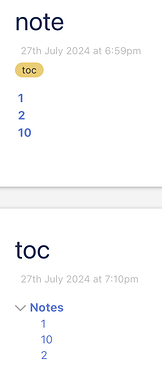The essence of the problem I bumped into is the following:
. Create three tiddlers (“notes”) with titles 1, 2, and 10, respectively (text not required) each tagged “note”.
. Create a toc tiddler “note” tagged “toc” with caption “Notes” and with the following content:
<div class="tc-table-of-contents">
<<toc "note" "nsort[]">>
</div>
The toc correctly sorts the notes numerically, as desired, due to the use of nsort, as illustrated below.
. Create a tiddler “toc” with the following content:
<div class="tc-table-of-contents">
<<toc-selective-expandable "toc">>
</div>
In the toc tiddler the second-level toc is not sorted correctly.
